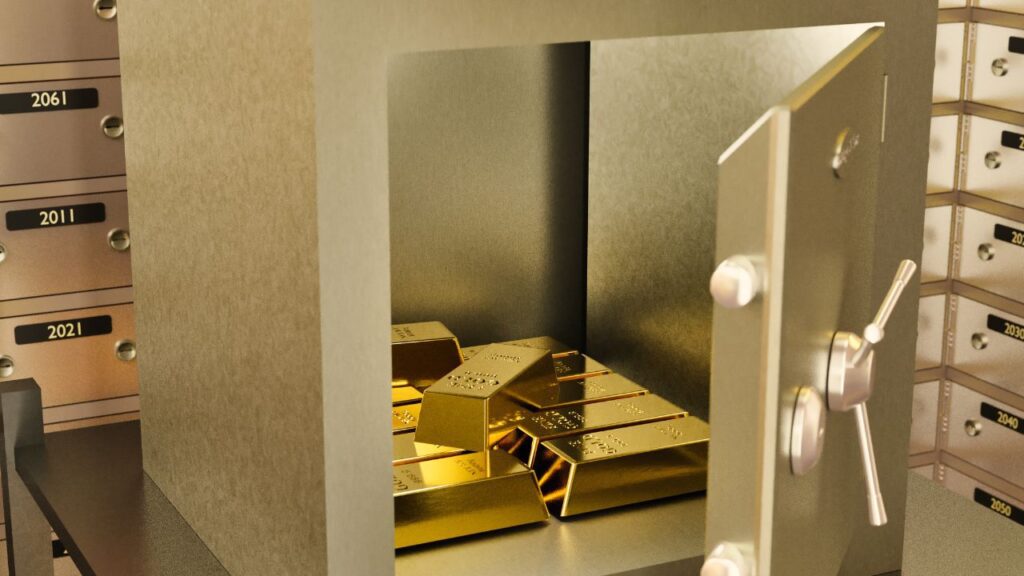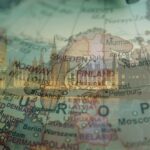Gold has long played a crucial role in the global monetary system. As of 2025, central banks across the world continue to rely on gold to diversify reserves, hedge against inflation, and signal financial strength. The yellow metal is a timeless store of value—less volatile than fiat currencies or stocks—making it a key component of national foreign exchange reserves.
While the total amount of mined gold globally is estimated to be over 216,000 tonnes, more than 36,000 tonnes are held by central banks alone. Let’s explore the top 30 countries with the largest official gold reserves, how much they hold, and what percentage of their forex reserves gold represents.
Global Ranking: Countries with Biggest Gold Reserves

1. United States
With 8,133.5 tonnes, the U.S. has held the world’s largest gold reserve since World War II. The bulk is stored in Fort Knox, with additional reserves at West Point and Denver. Gold accounts for 74.9% of its total reserves—a sign of deep reliance on this precious metal.
2. Germany
Germany holds 3,351.2 tonnes, second only to the U.S. Most of its reserves were repatriated from abroad over the past decade and are now split between Frankfurt, New York, and London. Gold makes up 77.1% of its forex reserves.
3. Italy
Italy’s central bank stores 2,451.8 tonnes of gold—74.1% of its forex reserves. Despite economic challenges, Italy has retained strong gold holdings as a symbol of national trust.
4. France
France holds 2,437.0 tonnes of gold. Its high ratio (74.7%) reflects a historical policy of using gold as monetary insurance.
5. Russia
Russia, with 2,332.7 tonnes, has increased its holdings dramatically since 2014 as a hedge against sanctions and USD exposure. Yet gold only accounts for 29.5% of its reserves.
6. China
China holds 2,292.3 tonnes, representing just 6.5% of its large foreign reserves. The People’s Bank of China continues to steadily increase gold holdings as part of its dedollarization strategy.
7. Switzerland
Home to one of the largest gold trading hubs (Zurich), Switzerland holds 1,039.9 tonnes of gold—9.6% of its forex reserves.
8. India
India, with 879.6 tonnes, sees gold as both a reserve and a cultural asset. The Reserve Bank of India has recently ramped up purchases, with gold now at 13.4% of reserves.
9. Japan
Japan holds 845.9 tonnes, but that only represents 6.6% of its reserves due to a massive treasury portfolio and U.S. dollar assets.
10. Turkey
Turkey’s 623.9 tonnes account for 43.6% of its reserves, reflecting the country’s push for currency independence amid inflation and lira volatility.
11. Netherlands
The Netherlands holds 612.4 tonnes—64.9% of its total forex reserves. It has modernized vault infrastructure and confirmed long-term commitment to gold.
12. Poland
Poland’s central bank owns 509.3 tonnes—a figure that’s grown fast in recent years. Gold now makes up 22% of its reserves, with more acquisitions underway.
13. Taiwan
Taiwan holds 422.4 tonnes, but only 4.7% of reserves are in gold, focusing instead on other foreign assets for reserve diversification.
14. Portugal
Portugal has 382.6 tonnes, comprising an impressive 84% of reserves—the highest percentage on this list. The country has kept its reserves intact despite fiscal crises.
15. Uzbekistan
Uzbekistan holds 367.6 tonnes, making gold a core part (77%) of its reserve strategy amid efforts to modernize its economy.
16. Saudi Arabia
Despite 323.1 tons, gold makes up just 4.7% of Saudi Arabia’s reserves, as it focuses more on dollar-based assets and oil-backed investments.
17. United Kingdom
The UK holds 310.2 tonnes of gold—about 16.8% of its total reserves. It also offers gold custodianship services for other nations via the Bank of England.
18. Kazakhstan
Kazakhstan holds 290.5 tonnes, representing 57.8% of its reserves. It has a strategic approach to gold mining and state-controlled exports.
19. Spain
Spain’s 281.5 tons account for 25% of reserves. Despite economic ups and downs, its gold holdings have remained stable.
20. Austria
Austria holds 279.9 tonnes—68.3% of its forex reserves. Its central bank recently repatriated some reserves back from the UK.
21. Thailand
Thailand stores 234.5 tonnes, or 9.5%, of its reserves. It is gradually shifting toward a more gold-inclusive reserve model.
22. Belgium
Belgium has 227.4 tonnes, amounting to nearly 50% of its total reserves—a sign of conservative monetary policy.
23. Singapore
Singapore holds 215.1 tonnes, with only 5.4% in gold. Known for its financial innovation, Singapore prefers diversified portfolios.
24. Algeria
Algeria’s 173.5 tonnes account for 21.2% of reserves. The nation uses gold to counter oil price volatility.
25. Venezuela
Venezuela holds 161.2 tonnes, a staggering 83% of reserves. However, much of it is inaccessible due to sanctions and legal battles abroad.
26. Philippines
The Philippines owns 159.1 tonnes, or 10.2% of reserves. The Bangko Sentral ng Pilipinas is increasingly turning to gold for reserve diversification.
27. Libya
Libya has 146.6 tonnes, representing 15.3% of reserves. Its central bank has managed to protect gold holdings despite ongoing civil instability.
28. Brazil
Brazil holds 129.6 tonnes, just 3.8% of its reserve base—one of the lowest ratios on the list. The country favors bond investments and USD reserves.
29. Egypt
Egypt has 128.2 tonnes, or 28% of reserves. The country has increased gold buying amid rising inflation and currency devaluation.
30. Sweden
Sweden rounds out the list with 125.7 tonnes, which is 19% of its forex holdings. Known for stable fiscal policy, gold is just one part of its reserve mix.
Top 30 Countries by Gold Reserves (Q1 2025)

|
Rank |
Country |
Gold Reserves (Tonnes) |
% of Forex Reserves |
|
1 |
United States |
8,133.5 |
74.9% |
|
2 |
Germany |
3,351.2 |
77.1% |
|
3 |
Italy |
2,451.8 |
74.1% |
|
4 |
France |
2,437.0 |
74.7% |
|
5 |
Russia |
2,332.7 |
29.5% |
|
6 |
China |
2,292.3 |
6.5% |
|
7 |
Switzerland |
1,039.9 |
9.6% |
|
8 |
India |
879.6 |
13.4% |
|
9 |
Japan |
845.9 |
6.6% |
|
10 |
Turkey |
623.9 |
43.6% |
|
11 |
Netherlands |
612.4 |
64.9% |
|
12 |
Poland |
509.3 |
22.0% |
|
13 |
Taiwan |
422.4 |
4.7% |
|
14 |
Portugal |
382.6 |
84.0% |
|
15 |
Uzbekistan |
367.6 |
77.0% |
|
16 |
Saudi Arabia |
323.1 |
4.7% |
|
17 |
United Kingdom |
310.2 |
16.8% |
|
18 |
Kazakhstan |
290.5 |
57.8% |
|
19 |
Spain |
281.5 |
25.0% |
|
20 |
Austria |
279.9 |
68.3% |
|
21 |
Thailand |
234.5 |
9.5% |
|
22 |
Belgium |
227.4 |
49.9% |
|
23 |
Singapore |
215.1 |
5.4% |
|
24 |
Algeria |
173.5 |
21.2% |
|
25 |
Venezuela |
161.2 |
83.0% |
|
26 |
Philippines |
159.1 |
10.2% |
|
27 |
Libya |
146.6 |
15.3% |
|
28 |
Brazil |
129.6 |
3.8% |
|
29 |
Egypt |
128.2 |
28.0% |
|
30 |
Sweden |
125.7 |
19.0% |
Takeaways
From the U.S.’s staggering 8,133.5 t to Sweden’s cautious 125.7 t, these top 30 nations showcase diverse gold strategies. While Western powers rely on high holdings for credibility and financial backbone, emerging and middle-income countries view gold as a hedge against inflation, geopolitical inflation, and dependency on the U.S. dollar. Q1 2025 data reveals ongoing central bank gold purchases—244 t globally, led by Poland, China, and Kazakhstan.
As geopolitical and economic uncertainties persist—from trade tensions to sanctions—gold remains not just a symbol of wealth but a critical instrument for national resilience. Whether viewed per capita or as a percentage of reserves, each country’s gold reserve strategy reflects its unique economic narrative and future-proofing priorities.


















![10 Countries With the Best Healthcare in the World [Statistical Analysis] Countries With the Best Healthcare in the World](https://articleify.com/wp-content/uploads/2025/07/Countries-With-the-Best-Healthcare-in-the-World-1-150x150.jpg)










